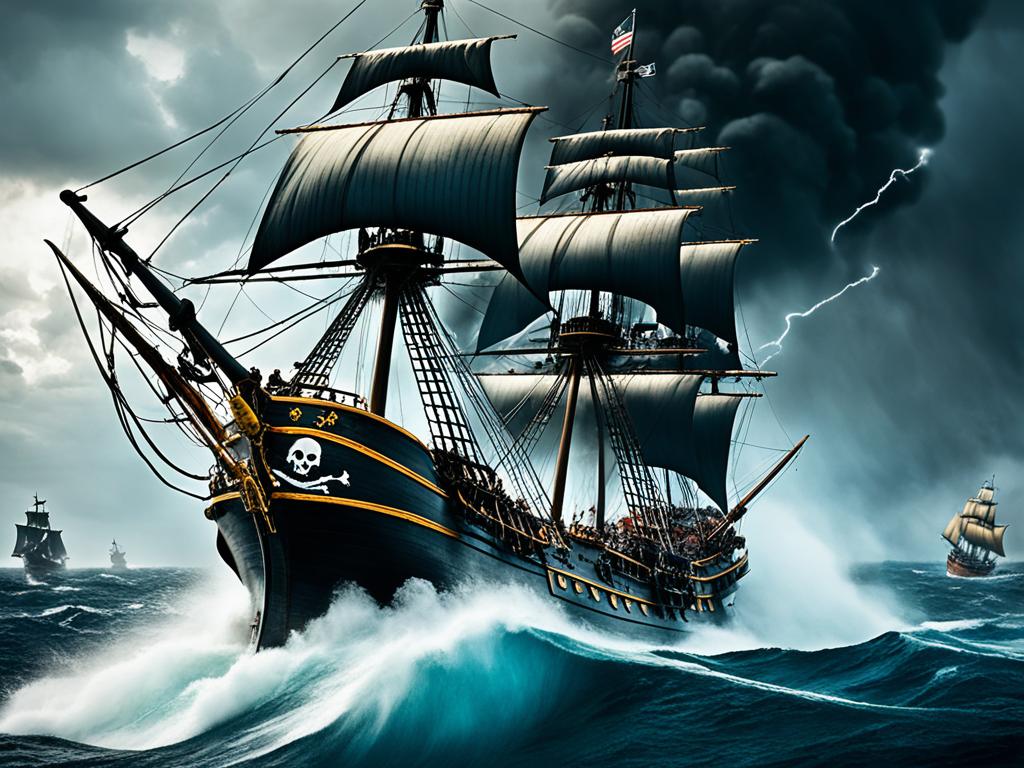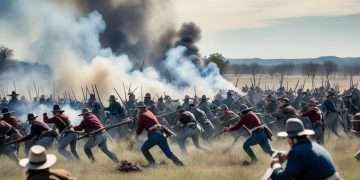Welcome to the fascinating world of the Golden Age of Piracy! This notorious era is shrouded in mystery and intrigue, with tales of swashbuckling pirates, hidden treasure, and daring adventures on the high seas. But how much of what we think we know is actually true?
In this article, we will separate fact from fiction and dive deep into the real stories behind the Golden Age of Piracy. From defining this captivating era to exploring the lives of famous pirates, we’ll uncover the truth behind the legends and myths that have captured our imaginations for centuries.
So join us on this unforgettable journey as we set sail on the historical seas and discover the facts behind the Golden Age of Piracy!
Key takeaways:
- The Golden Age of Piracy is a fascinating era filled with myths and legends.
- This article will separate fact from fiction and delve into the real stories behind the pirates of this time.
- From defining the Golden Age to exploring the lives of famous pirates, we’ll uncover the truth behind the swashbuckling tales we’ve come to know.
- Join us on this historical journey to gain a deeper understanding of the Golden Age of Piracy.
- Stay tuned to learn more about the reality behind the legends!
Defining the Golden Age of Piracy
The Golden Age of Piracy, a captivating period in history, refers to the era when piracy thrived in various parts of the world. From the early 17th century to the early 18th century, pirates ruled the seas, striking fear into the hearts of sailors and merchants alike.
The defining characteristics of this infamous era were not only the daring acts of piracy committed by individuals and organized pirate crews, but also the socio-economic factors that contributed to the rise of piracy during this time.
The Golden Age of Piracy primarily encompassed the Caribbean Sea, the West African coast, and the Indian Ocean. These maritime regions were hotbeds of pirate activity due to their strategic locations, bustling trade routes, and the presence of vulnerable merchant ships carrying valuable cargo.
But what transformed this era into the “Golden Age” of piracy? It was the perfect storm of social and economic circumstances. The aftermath of wars and political instability left many sailors unemployed, searching for alternative means of livelihood. The prospect of wealth, freedom, and adventure enticed them to turn to piracy.
The lucrative spoils of piracy, including stolen goods, gold, and jewels, acted as powerful incentives for individuals to take up a life of crime on the high seas. The allure of a pirate’s life, filled with danger, camaraderie, and the possibility of great riches, became an irresistible temptation for many.
The image of the swashbuckling pirate, with a patched eye, a parrot on the shoulder, and a cutlass at hand, may be ingrained in popular culture, but the reality of piracy during the Golden Age was far more complex. Pirates operated under a set of rules known as the “Pirate Code,” which ensured fair treatment and democratic decision-making within their crews.
Now, let’s explore the time period and key geographical locations that define the Golden Age of Piracy in the following table:
{{
| }}Time Period{{ | }} {{ |
}}Geographical Locations{{ | }} {{ |
|---|---|---|---|
| }}Early 17th century to early 18th century{{ | }}Caribbean Sea{{ | ||
| }}West African coast{{ | }}Indian Ocean{{ |
}}
The table provides a clear overview of when and where the Golden Age of Piracy occurred, enabling a deeper understanding of this fascinating period in history.
Famous Pirates and Their Exploits
During the Golden Age of Piracy, several infamous pirates rose to prominence with their daring exploits and notorious battles. Let’s delve into the lives of three legendary figures who left a lasting impact on piracy during that time.
Blackbeard
Edward Teach, popularly known as Blackbeard, was one of the most feared and famous pirates of the era. With his intimidating appearance, featuring a thick black beard and multiple pistols strapped across his chest, Blackbeard struck fear into the hearts of his victims.
Blackbeard became notorious for capturing and looting numerous ships in the Caribbean and along the American colonies. His flagship, the Queen Anne’s Revenge, was a symbol of his dominance and brutality on the high seas.
“Blackbeard’s reign of terror solidified his status as one of the most feared pirates of all time,” historian Robert Lee comments.
Blackbeard’s life came to a violent end in 1718 during a fierce battle with British naval forces off the coast of North Carolina. Despite his demise, his legacy as a fearsome pirate endures to this day.
Captain Kidd
William Kidd, known as Captain Kidd, started his career as a privateer before turning to piracy. His reputation took a legendary turn when he was accused of piracy and murder.
Kidd was often considered a controversial figure. While some believed he was unjustly accused, others saw him as a cunning and ruthless pirate. His most famous exploit was the capture of the Quedagh Merchant, an Armenian vessel reputed to be carrying valuable treasures.
“Captain Kidd’s story is a complex and debated one, leaving questions about his true nature and motivations,” maritime historian Sarah Williamson explains.
Captain Kidd’s trials and eventual execution in 1701 marked the end of his brief but impactful career as a pirate.
Anne Bonny
Anne Bonny, a fierce female pirate, challenged the traditional gender norms of the time. Born in Ireland, Bonny found herself drawn into the world of piracy alongside her partner-in-crime, Calico Jack Rackham.
Bonny’s exploits included actively participating in battles and commanding her own crew. Her fearlessness and determination earned her respect among her fellow pirates.
“Anne Bonny’s defiance of societal expectations and her daring escapades at sea made her a true pirate legend,” historian Elizabeth Adams highlights.
Despite her remarkable career, Anne Bonny’s pirate life came to an end when she was captured and sentenced to death. However, her legacy serves as an inspiration for women in the world of piracy and beyond.
These are just three examples of the famous pirates who dominated the Golden Age of Piracy. Their exploits remain an important part of maritime history and continue to captivate the imagination of people around the world.
| Pirate | Notable Exploits |
|---|---|
| Blackbeard | Capturing and looting numerous ships in the Caribbean and American colonies |
| Captain Kidd | Capture of the Quedagh Merchant, a vessel believed to carry valuable treasures |
| Anne Bonny | Active participation in battles, commanding her own crew |
Life Aboard a Pirate Ship
When you imagine the life of a pirate, you might envision a thrilling adventure on the high seas. But the reality of life aboard a pirate ship was far from glamorous. It was a harsh existence filled with danger, hard work, and strict rules.
On a pirate ship, the crew had a strict hierarchy. The captain, often feared and respected, was responsible for making decisions and enforcing discipline. The quartermaster, chosen by the crew, acted as a mediator between the captain and the crew, ensuring fair treatment and distributing provisions.
Life aboard the pirate ship was marked by difficult conditions. Sailors faced the relentless ocean, battling storms and unpredictable weather. The cramped and unsanitary living quarters provided little relief, and disease was a constant threat. Pirates also had to contend with shortages of food and water, relying on meager rations and plundering other ships for supplies.
The code of conduct followed by pirates was known as the “Pirate’s Code.” This code established rules and regulations that governed behavior on the ship. It covered everything from division of loot to discipline for theft or betrayal. Adhering to the code was crucial to maintaining order and harmony among the crew.
“Every man shall have an equal vote in affairs of moment; the captain shall have two votes. Every man shall be called fairly in turn by the list on board of prizes, because over and above their proper share, they have a short jacket and a pair of breeches.” – Bartholomew Roberts
Daily life on a pirate ship was filled with challenges. Sailors had to be on constant lookout for other ships to plunder or enemies to defend against. They had to navigate treacherous waters and be ready for battle at a moment’s notice. Surviving as a pirate required a combination of skill, bravery, and endurance.
The Hierarchy of a Pirate Ship
Life aboard a pirate ship was governed by a strict hierarchy. Each crew member had a defined role and set of responsibilities.
| Position | Description |
|---|---|
| Captain | The ultimate authority on the ship responsible for making decisions and enforcing discipline. |
| Quartermaster | Chosen by the crew to act as a mediator between the captain and the crew, ensuring fair treatment and distributing provisions. |
| Boatswain | In charge of maintaining the ship’s equipment and overseeing repairs. |
| Gunner | Responsible for managing and maintaining the ship’s cannons and artillery. |
| Helmsman | In charge of steering the ship and navigating through treacherous waters. |
| Sailors | Responsible for operating the ship and carrying out various tasks such as hoisting sails, repairing rigging, and manning the cannons during battle. |
| Swabbies | The lowest-ranking members of the crew, responsible for cleaning and maintaining the ship. |
Life aboard a pirate ship was not for the faint of heart. It was a challenging and perilous existence. But for those who were drawn to the allure of the pirate life, it offered a sense of freedom, adventure, and camaraderie that couldn’t be found anywhere else.
The Truth Behind Pirate Legends
Throughout history, pirate legends have captured our imaginations with tales of swashbuckling adventures on the high seas. But how much of these stories are true, and how much is simply the product of myth and folklore? Let’s separate fact from fiction as we delve into the truth behind these captivating pirate legends.
1. The Appearance of Pirates
When we think of pirates, we often picture them wearing an eye patch, a peg leg, and a skull and crossbones hat. However, the truth is that pirates did not all fit this stereotypical image. While some pirates did have missing limbs or eye injuries, many looked just like any other sailor of the era. Their appearance was influenced by practicality rather than flashy accessories. The goal for pirates was to blend in as much as possible to avoid detection.
2. Buried Treasure
One of the most enduring pirate myths is the idea that they buried their treasure on remote islands or deserted beaches. While pirates did accumulate wealth through their acts of piracy, most of their spoils were immediately spent on necessities such as food, clothing, and ship repairs. The idea of hidden treasure was mainly popularized by works of fiction and has become synonymous with pirates in popular culture.
“Arr, me hearties! Ye won’t see me buryin’ me gold anytime soon. It’s best to spend it while ye still can!”
3. Treatment of Captives
Another common misconception is that pirates were ruthless and merciless towards their captives, often resorting to violence or even walking them off the plank. While it is true that pirates used intimidation tactics to strike fear into the hearts of their victims, most avoided needless bloodshed. Pirates recognized that hostages could be a valuable bargaining chip, and keeping captives alive increased their chances of obtaining ransom or leveraging diplomatic negotiations.
To gain a deeper understanding of the truth behind pirate legends, let’s take a closer look at some real stories from the Golden Age of Piracy:
| Pirate Legend | Truth |
|---|---|
| Blackbeard | Blackbeard, also known as Edward Teach, was a fearsome pirate known for his intimidating appearance. He tied slow-burning fuses into his beard, creating a menacing effect to intimidate his enemies. |
| Anne Bonny | Anne Bonny was a skilled pirate who fought alongside her husband. She was known for her fierce temper and skills with a cutlass. |
| Captain Kidd | Captain Kidd was initially commissioned by the British government to hunt down pirates, but he eventually turned to piracy himself. He was tried and executed for his crimes, leaving behind a controversial legacy. |
Unveiling the Truth
By separating fact from fiction, we can uncover the true stories and fascinating history of the Golden Age of Piracy. While the legends surrounding pirates may have been exaggerated over time, there is no denying the lasting impact these maritime outlaws have had on popular culture.
Continue your journey through the Golden Age of Piracy as we uncover the end of this infamous era in Section 6: The End of the Golden Age.
The End of the Golden Age
As the 18th century progressed, the Golden Age of Piracy began to wane. The once-feared pirates faced numerous challenges that led to their eventual downfall. Advancements in maritime warfare, the concerted efforts of naval forces, and changes in the political landscape all played a significant role in bringing an end to this infamous era.
The naval powers of the time recognized the growing threat posed by pirates and took decisive action to combat their activities. Nations such as England, Spain, and France bolstered their naval forces, equipping them with more advanced weaponry and technology. With improved naval capabilities, they were able to effectively hunt down and capture pirate ships, disrupting their illicit operations.
The development of more powerful warships also contributed to the decline of piracy. Ships armed with heavy cannons and manned by skilled naval officers had the upper hand in confrontations with pirate vessels. Pirates, who largely relied on small, swift ships, found themselves outmatched in these battles. The odds were no longer in their favor.
The political landscape of the era also played a pivotal role in the downfall of the Golden Age of Piracy. The signing of treaties and the establishment of alliances between nations meant that pirates faced united opposition. The international efforts to suppress piracy proved increasingly effective, leaving pirates with limited safe havens and opportunities for plunder.
In addition to external forces, internal conflicts also contributed to the end of the Golden Age. Rivalries among pirates themselves, power struggles, and mistrust weakened their ranks. The once tight-knit pirate communities began to fracture, making them vulnerable to their enemies.
The decline of the Golden Age of Piracy marked a significant shift in the maritime landscape. The era of lawlessness and rampant piracy gave way to increased security and stricter enforcement of maritime laws. While piracy did not completely disappear, it became increasingly difficult for pirates to operate with the same level of success and freedom they once enjoyed.
“The end of the Golden Age of Piracy represented a turning point in naval history. The efforts to suppress piracy not only reduced criminal activities at sea but also paved the way for the establishment of stronger, more secure trade routes.”
Piracy’s Impact on Maritime Trade
The Golden Age of Piracy left a lasting legacy on maritime trade. The constant threat of pirates disrupted international commerce and undermined the stability of trade routes. As piracy declined, nations were able to restore a sense of security to their sea lanes, promoting economic growth and the expansion of global trade networks.
| Before the Golden Age of Piracy | After the Golden Age of Piracy | |
|---|---|---|
| Trade Disruptions | The activities of pirates caused frequent disruptions to trade, leading to higher costs and increased risks for merchants. | With piracy under control, trade routes became safer and more reliable, stimulating economic growth and encouraging further exploration. |
| Insurance Costs | Merchant ships had to pay exorbitant insurance premiums to protect themselves against pirate attacks. | The decrease in piracy reduced insurance costs for merchants, making trade more affordable and profitable. |
| Global Commerce | Restrictions on trade due to piracy limited the scope and reach of global commerce. | With piracy contained, global commerce expanded, opening up new markets and opportunities for economic development. |
The end of the Golden Age of Piracy brought about a new era of stability and order at sea. While the tales of pirates continued to captivate the imagination, the days of their reign were nearing an end. The decline of this notorious era paved the way for a safer and more prosperous future for maritime trade.
Piracy’s Legacy in Popular Culture
The Golden Age of Piracy has left an indelible mark on popular culture, captivating audiences across various forms of media. From books to movies, video games to theme park attractions, the legends and lore of this era continue to enthrall and inspire.
In literature, countless authors have drawn upon the intrigue and adventure of piracy to create captivating stories. From classic novels like Robert Louis Stevenson’s “Treasure Island” to contemporary series like Pirates of the Caribbean, piracy’s legacy has sparked imaginations and transported readers into thrilling worlds of treasure maps, hidden caves, and daring escapades on the high seas. The allure of pirate characters, with their unmistakable eyepatches, peg legs, and skull-and-crossbones flags, has become iconic in popular culture.
Movies have also played a significant role in immortalizing piracy’s legacy. Films like “Captain Blood,” “Pirates of the Caribbean,” and “Black Sails” have brought swashbuckling adventures to the silver screen, captivating audiences with epic battles, larger-than-life characters, and tales of treasure and betrayal. The popularity of these movies showcases the enduring appeal of piracy’s legacy, drawing viewers of all ages into the captivating world of pirates.
“Arr, matey! Set sail for adventure and join the crew of the Black Pearl as they search for cursed treasure and battle the undead in the legendary ‘Pirates of the Caribbean’ movie franchise!”
In the realm of gaming, piracy’s legacy has inspired countless video games that allow players to embrace their inner pirate. From the classic “Sid Meier’s Pirates!” to the immersive world of “Assassin’s Creed IV: Black Flag,” gamers can step into the shoes of a pirate captain, sail the open seas, and engage in thrilling naval battles. These games provide an interactive experience that allows players to explore the Golden Age of Piracy and shape their own pirate tales.
Theme parks around the world have also embraced piracy’s legacy, offering visitors the chance to embark on thrilling pirate-themed rides and experiences. From Disney’s Pirates of the Caribbean attraction, which was inspired by the iconic movie franchise, to Universal’s Skull Island: Reign of Kong, which takes guests on a perilous journey through a pirate-infested island, these immersive experiences bring the excitement and adventure of piracy to life.
Conclusion
In conclusion, we have unraveled the truth behind the swashbuckling myths of the Golden Age of Piracy. By understanding the reality of this era, you gain a deeper appreciation for the history of piracy and its lasting legacy in popular culture.







